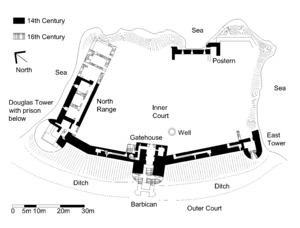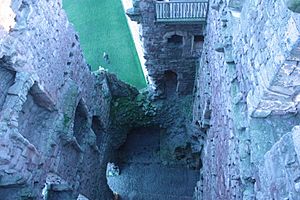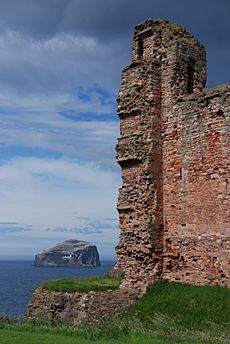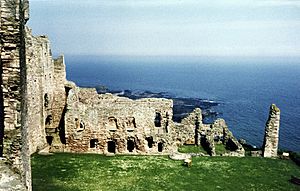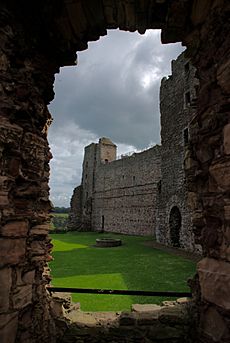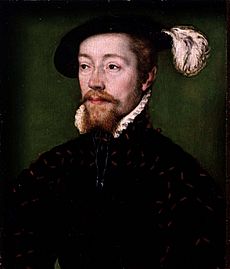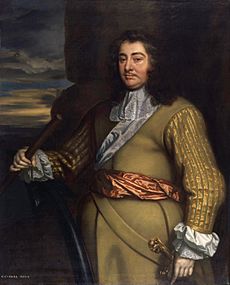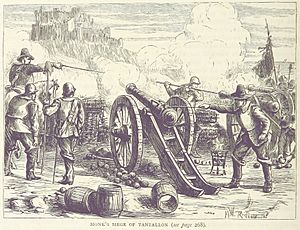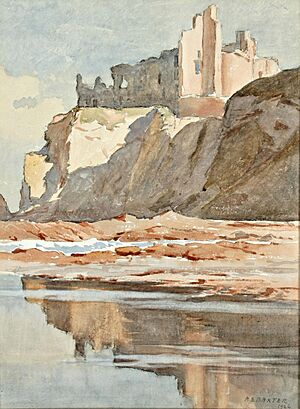Tantallon Castle facts for kids
Quick facts for kids Tantallon Castle |
|
|---|---|
| East Lothian, Scotland OSGB grid reference NT596851 |
|

Approach to Tantallon from the south
|
|
| Coordinates | 56°03′23″N 2°39′02″W / 56.0564°N 2.6506°W |
| Type | Castle of enceinte |
| Site information | |
| Owner | Historic Environment Scotland |
| Controlled by | Earl of Angus |
| Open to the public |
Yes |
| Condition | Ruined |
| Site history | |
| Built | c.1350 |
| Built by | William Douglas, 1st Earl of Douglas |
| In use | Until 1650 |
| Materials | Stone |
Tantallon Castle is a ruined fortress built in the mid-1300s. It is located about 5 kilometers (3 miles) east of North Berwick in East Lothian, Scotland. The castle sits on a high piece of land that sticks out into the sea. It faces the Bass Rock and looks over the Firth of Forth. Tantallon was the last medieval castle in Scotland built with only a single main wall. This wall blocked off the land side of the headland. The other three sides were naturally protected by tall sea cliffs.
William Douglas, 1st Earl of Douglas built Tantallon in the mid-14th century. It later went to his son, George Douglas, 1st Earl of Angus. Even after several attacks, the castle stayed with his family for most of its history. King James IV of Scotland attacked it in 1491. His son, James V of Scotland, attacked it again in 1527, causing a lot of damage. Tantallon was also involved in the First Bishops' War in 1639. It saw more fighting during Oliver Cromwell's invasion of Scotland in 1651. It was badly damaged once more. The Marquis of Douglas sold the castle in 1699. Today, Historic Environment Scotland looks after the ruins.
Contents
Building Tantallon Castle
Tantallon Castle is very special in Scotland. Its defenses are just one huge wall that protects a piece of land by the sea. The sides facing the sea are naturally safe because of steep cliffs. These sides only had small defensive walls. To the southwest, a massive main wall, called a curtain wall, blocks off the land. This wall creates the castle's inner courtyard.
The curtain wall is made from local red sandstone. It has a tower at each end and a strong gatehouse in the middle. All these parts had rooms for people to live in. A row of buildings to the north, including a large hall, completed the main castle. This created a courtyard about 70 by 44 meters (230 by 144 feet) in size. In total, the castle buildings had about 1,100 square meters (11,800 sq ft) of living space.
Tantallon is like older castles from the 12th century, such as Bothwell Castle and Kildrummy Castle. These were "curtain wall castles," meaning they relied on a strong outer wall. Tantallon was the last of this type built in Scotland. Smaller castles, called tower houses, were becoming more popular. For example, Threave Castle, built around the same time, was a much smaller tower. Tantallon also shares features with "courtyard" castles like Doune Castle. These castles also had entrances through a passage under a strong tower.
The Great Curtain Wall
The main curtain wall is over 15 meters (49 feet) high. It is 3.6 meters (12 feet) thick and about 90 meters (300 feet) long. Inside the walls, there are small rooms and stairs. These stairs have arched ceilings and lead up to the top walkway. This walkway, below the 16th-century crenels (gaps for shooting), connects the three towers.
The tower on the northwest side is called the Douglas Tower. It was round and 12 meters (39 feet) across, though its west side has fallen down. This tower was seven stories high. It would have been the lord's "donjon" or keep, which was his private living area. It also connected to the main hall in the north buildings. The lowest floor was a pit prison. The rooms above had wooden floors and private toilets, called garderobes.
The East Tower is shaped like a "D," with the curved side facing outwards. It is 9 meters (30 feet) across. It originally had five stories. After the 1528 attack, the bottom three floors were changed into two by adding stone arches. Large openings for cannons were also added in the basement at this time. The third floor of this tower was planned to connect to a walkway on the southeast wall, but this wall was never built.
The central gatehouse tower is square, 13 meters (43 feet) across, and up to 24 meters (79 feet) high. It had four stories of rooms, some with fancy fireplaces. However, the inside walls and floors are now gone. The main entrance went through a passage below. This passage was protected by a drawbridge, three sets of doors, a portcullis (a heavy gate that drops down), and machicolations. These were holes in the ceiling that allowed defenders to drop things on attackers below. There are two small corner turrets, called bartizans, facing the courtyard. A spiral staircase from the 16th century leads up to the top of the curtain wall.
The entrance was first a pointed archway with round towers on each side. An outer gate, called a barbican, was added in the early 14th century. This was destroyed in the 1528 attack, but you can still see parts of it. After the attack, the front of the gatehouse was rebuilt. More cannon openings were added at ground level, and the entrance passage was made narrower. The rebuilding covered the old round towers and made the main gate smaller. It also gave the tower rounded corners to make it stronger.
Inside the Castle Walls
The north range of buildings, about 10 by 40 meters (33 by 131 feet), connects to the Douglas Tower. The western part is from the 14th century. It contains the remains of the great hall, used by the lord. Below it was the low hall, used by workers, which was later divided into cellars. You can see where the hall's sloped roof met the inside wall of the Douglas Tower. The eastern part, built in the 16th century, had a bakehouse and more private rooms. This section has partly fallen into the sea. Only a small part of the other walls remains to the east. It has a postern gate, a secret entrance to the sea through a crack in the cliffs below. The castle's well is 32 meters (105 feet) deep and was dug out again in the 1800s.
The Outer Areas
Next to the main curtain wall is a deep ditch cut into the rock. A second, larger ditch is about 100 meters (330 feet) away. This marks the castle's outer court. Inside the outer ditch are two mounds. Some experts think these might hide 16th-century caponiers. These were defensive spots that allowed soldiers to fire along the trench.
A stone-faced mound used to run along the outside of the ditch. Only a 30-meter (98-foot) section of this outer wall remains at the south end. It ends in a two-story round tower. This tower, with several cannon openings, was built before the 1528 attack. It might have been inspired by new artillery defenses at nearby Dunbar Castle. A 17th-century "lectern" type doocot, or pigeon house, is the only building in the outer court. Beyond the outer ditch is a 17th-century ravelin, which is a triangular earth defense for cannons. There are also remains of a third, smaller ditch.
Castle History
An old map from before 1300 shows a castle-like place called "Dentaloune." This name might come from an old Celtic language, meaning "high-fronted fortress." At that time, the land around North Berwick, including Tantallon, belonged to the Earls of Fife.
Early Years
In 1346, William Douglas, 1st Earl of Douglas (around 1327–1384) came back to Scotland from France. He was the nephew of Sir James Douglas, Lord of Douglas, a friend of Robert the Bruce. William wanted to claim his family's lands. He became the leader of the Douglas family after a conflict with his godfather. In 1358, he was made the Earl of Douglas.
It's not clear how Douglas got Tantallon. But in 1374, he called it "our castle of Temptaloun." Douglas might have been made the castle's keeper by Isabella, Countess of Fife. It seems he built the current castle either just before or after he became an Earl. He wanted it to show his new high status. Even though it was a medieval curtain wall castle, this style was becoming old-fashioned. The Douglas family continued to hold Tantallon as tenants of Robert Stewart, Earl of Fife, from 1371 to 1372. Then, Robert Stewart gave the title to his son, Murdoch Stewart.
Tantallon was home to William Douglas's sister-in-law and mistress, Margaret Stewart, 3rd Countess of Angus. She was the mother of his son, George Douglas, 1st Earl of Angus (1380–1403). In 1377, the Earl of Angus made his friend, Alan de Lawedre, the Constable (keeper) of Tantallon Castle. He held this job until at least 1389. In 1388, when the 2nd Earl of Douglas died, the Earl of Fife claimed Tantallon. But he confirmed the Countess's right to live there. After some disagreements, an agreement was made in 1389. George Douglas was recognized as the Earl of Angus.
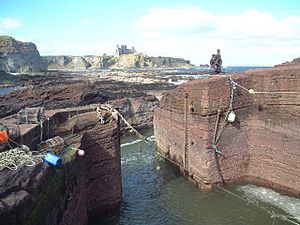
The Red Douglases Take Over
The land around Tantallon stayed with the Earldom of Fife. But the castle itself passed to the Douglas family. It was inherited by George Douglas, the son of the Earl of Douglas, who also became the Earl of Angus in 1389. This created a split in the Douglas family. Archibald the Grim led the main line, known as the "Black Douglases." George Douglas started the "Red Douglases."
In 1397, George Douglas married Princess Mary Stewart, the daughter of King Robert III of Scotland. This connected the Red Douglases to the Royal House of Stewart. From 1425 to 1433, Isabella, Countess of Lennox, the wife of the executed Duke of Albany, was held at Tantallon. In 1429, another royal enemy, Alexander of Islay, Earl of Ross, was held there until he made peace with King James I two years later.
The 3rd Earl of Angus (1426–1446) made Tantallon his main home. He was in rebellion from 1443 until he died. He attacked the Black Douglas lands, which led to him losing his own lands in 1446, just before his death. In 1452, King James II gave Tantallon to the 4th Earl of Angus. He was the 3rd Earl's brother. He led the Royal army that defeated the Black Douglases in 1455.
Archibald Douglas, 5th Earl of Angus, known as "Bell-the-Cat," turned against the Royal family in 1482. Around 1490, Angus made a secret agreement with Henry VII of England against James IV of Scotland. On October 11, 1491, James IV attacked Tantallon Castle. He used cannons from Edinburgh and Linlithgow, and crossbows and early handguns from Leith. However, Angus gave up, and the castle was not badly damaged. By 1493, Angus was back in favor as the Chancellor of Scotland. In 1498, Patrick Mathewson was the Constable of Tantallon Castle.
The Attack of 1528
In 1514, Archibald Douglas, 6th Earl of Angus (1490–1557) married James IV's widow, Margaret Tudor. She was the daughter of Henry VII and was in charge of Scotland for her young son, James V of Scotland. The couple tried to take the young King to England, which started a civil war. The Duke of Albany took over as Regent and captured Tantallon in 1515. But it was given back when Angus made peace. Margaret Tudor stayed at Tantallon on her way to England in 1515. She left valuable clothes and jewels there, including a diamond from the King of France.
In 1525, Angus, with help from Henry VIII of England, took control of the young King. He became Chancellor. But in 1528, the sixteen-year-old James V escaped. He joined his mother at Stirling Castle and declared Angus a traitor. Angus was banished to "north of the Spey." Instead, Angus went back to Tantallon and made it stronger. On October 23, 1528, King James attacked Tantallon. Angus's servant, Simon Penango, defended it. Angus himself stayed nearby.
The King's Master of Artillery, Alexander Jardine, planned the attack. James V borrowed cannons from Dunbar Castle, which was held by French soldiers. According to a historian, the cannons included "Thrawinmouth," "Mow and her marrow," two large "botcards," two "moyanes," two "double falcons," and four "quarter falcons." These were all types of early cannons. James left three hostages to guarantee the return of the guns. The castle was bombarded for 20 days. However, the King's cannons could not get close enough to the walls to do much damage because of the deep outer ditch. The King stopped the attack and went back to Edinburgh. Then, Angus attacked and captured the King's cannons. The King's main gunner was killed.
Angus wrote to the Earl of Northumberland that James V had brought Scottish and French engineers to the attack without success. He said that never before had so much effort and money been spent trying to capture a house in Scotland, and it still escaped. In May 1529, Angus fled to England, leaving the castle to James. Simon Penango, who had no more supplies, made a deal and surrendered the castle. Tantallon remained a Royal fortress until James V died in 1542. Then, Angus returned and got it back.
To fix the damage from the attack, the King began rebuilding and strengthening the castle. First, Sir Thomas Erskine of Haltoun, the king's secretary, became the keeper and organized repairs. He was at the castle in July 1533. Then the castle was given to the king's oldest son, James. Soon after, Oliver Sinclair became captain. Records from 1537–1539 show that George Sempill was the master mason. He did the repairs under the direction of John Scrimgeour of Myres, the King's Master of Works. The front of the gatehouse was rebuilt, and the East Tower was made stronger. Wide cannon holes were added to the landward walls of the tower. A crenellated parapet (a wall with gaps for defense) was added to the curtain wall. To make the great landward curtain wall stronger, several rooms and passages inside were filled with stone. You can still see this today. A historian described this, saying the king "caused masons come and ranforce the wallis, quhilkis war left waste before as transis (passages), and through-passages; and maid all massie work, to mak it the more strang."
The Rough Wooing Period
When Angus returned in 1542, he was still in touch with Henry VIII of England. He allowed Sir Ralph Sadler, the English ambassador, to stay at Tantallon. This was during talks to arrange a marriage between the young Mary, Queen of Scots, and Edward, Prince of Wales, in 1542–43. Some say that when the Earl of Hertford invaded Scotland in 1544, during the War of the Rough Wooing, the English army avoided Tantallon. This was because of the Earl's English connections. However, Hertford wanted to put an English army in Tantallon. He tried to negotiate with one of the keepers but failed. The nearby castle of Oliver Sinclair was among the places burned by the English army in May 1544. Tantallon was also left alone in 1547. Angus was finally put in prison at Blackness Castle in 1544. After that, he changed sides to support Scotland. The cannon operators at Tantallon were rewarded in August 1548. This was after they fired on English ships during a battle in the Firth of Forth.
Late 1500s
Angus died at Tantallon in January 1557. The army of Queen Regent, Mary of Guise, then took the castle. Simon Preston of Craigmillar was made keeper, and repairs were done the next year. Six workers spent 10 days in April 1558 cleaning out the well. George Drummond of Blair was keeper of Tantallon. He had a small army of seven horsemen and 22 soldiers.
James Douglas, 4th Earl of Morton took control in 1565 for his nephew, the young 8th Earl of Angus. But the next year, Mary, Queen of Scots, gave the Captaincy to Robert Lauder of the Bass and his son. This happened after Sir William Douglas of Lochleven surrendered. He was one of those accused of killing Queen Mary's friend, David Rizzio, in March 1566. Mary herself visited Tantallon in November 1566.
Andrew Hume was Captain of Tantallon Castle in 1577. The 8th Earl of Angus was sent away to England in 1581. He left some of his best furniture from Tantallon with Henry Carey, 1st Baron Hunsdon in Berwick-upon-Tweed. This included a bed of green velvet and another of crimson velvet with gold images. He had a brewery in the castle repaired in September 1583. In April 1584, the keepers of Fast Castle, Innerwick, and Tantallon were ordered to give their castles to the crown.
After the 8th Earl died in 1588, the Earls of Angus usually lived elsewhere. They had little to do with Tantallon Castle. In February 1592, a list was made of the castle's furniture and weapons. In July, James VI took possession of the castle. Alexander Home of North Berwick was made captain. In September 1596, the captain of Tantallon, Stephen Bruntfield, was killed by James Carmichael. Carmichael was the son of Sir John Carmichael, Captain of the Royal Guard. Bruntfield's brother later killed Carmichael in a duel. William Douglas, 10th Earl of Angus moved into the castle on November 5, 1608.
The 1600s
After a time of peace, Tantallon saw fighting again during the Bishops' Wars in 1639. The Douglas family had remained Catholic after the Scottish Reformation. This angered the Presbyterian Covenanters, who were against Charles I's attempts to change the Scottish Church. In 1639, the Covenanters captured Tantallon. At that time, William Douglas, 1st Marquess of Douglas, was in Edinburgh.
In 1650, during the Third English Civil War, Oliver Cromwell's forces invaded Scotland. They took control of the south after winning the Battle of Dunbar in September. In February 1651, Cromwell found that his supply lines were being attacked. A small group of Royalists based at Tantallon was causing trouble. This group, led by Alexander Seton, 1st Viscount of Kingston, had only 91 men. Despite this, Cromwell sent 2,000 to 3,000 troops under General Monck. He also sent most of his cannons in Scotland to attack Tantallon. Seton was made a Viscount by Charles II on February 14, during the attack. After twelve days of cannon fire, a hole was made in the Douglas Tower. The defenders had to give up. But they were allowed to leave safely because of their bravery. After this attack, Tantallon was left in ruins. It was never fixed or lived in again. The attack on Tantallon was also special because Cromwell's land forces were helped by the navy.
Also in 1651, the castle's dungeon was used. The Captain of the Bass Rock captured an English ship. It was carrying supplies for the English army, including 6,000 pairs of boots, 5,000 saddles, and 10 tons of London beer. The captured crew were put in Tantallon's dungeon.
Later Years
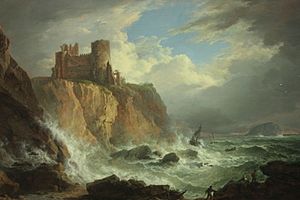
James Douglas, 2nd Marquess of Douglas, who was also the 12th Earl of Angus, had to sell his lands. This was because of gambling debts he and his father had. In 1699, the ruined Tantallon was sold to Sir Hew Dalrymple, Lord North Berwick. He was a judge and also owned land in the area, including the Bass Rock. Dalrymple allowed the castle to fall apart even more. Some of its stones were even taken to be used elsewhere. Sir Walter Scott wrote a long description of the castle in his 1808 poem Marmion.
The Dalrymple family did some repairs in the late 1800s. In 1924, the castle was given to the UK Government's Office of Works. This was done by Dalrymple's descendant, Sir Hew Hamilton-Dalrymple.
In 1944, the Castle played a part in preparing for the Normandy invasion. A few weeks before D-Day, captured German radar systems were moved to the Castle. These were the types of radar the Germans used to defend the French coast. At Tantallon, these radars were used to train RAF bomber crews. This included the famous "Dambusters" squadron. They were part of a huge effort to trick the Germans about where the Allied invasion would actually happen.
Starting the night before the D-Day landings, thin strips of aluminum foil were dropped by bombers. These strips were dropped in huge numbers, in carefully planned patterns, over many hours. This happened near two places far from Normandy. The hope was that the bombers would create an illusion on German radar. It would look like huge naval fleets were approaching, even though these "fleets" did not exist. This technique was perfected in the waters off Tantallon Castle. It was carried out by the bomber crews on the night of June 5–6, 1944, off the coast of France.
Today, Historic Environment Scotland cares for the Castle. It is a Scheduled Ancient Monument.
Ghost Stories
In modern times, there are several ghostlore stories about the castle and the area around it.
See also
 In Spanish: Castillo Tantallon para niños
In Spanish: Castillo Tantallon para niños




